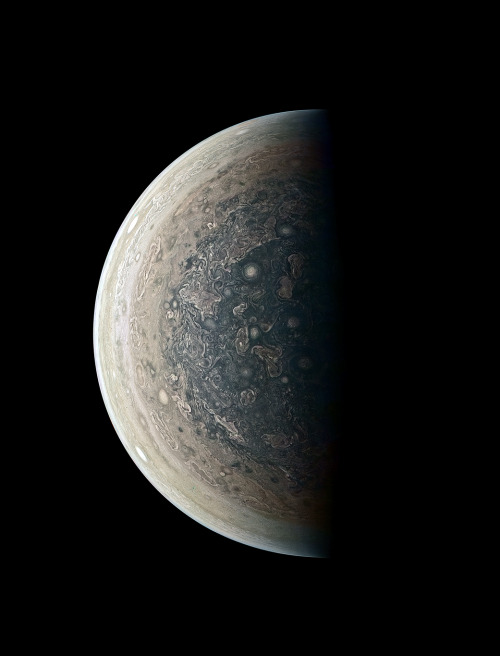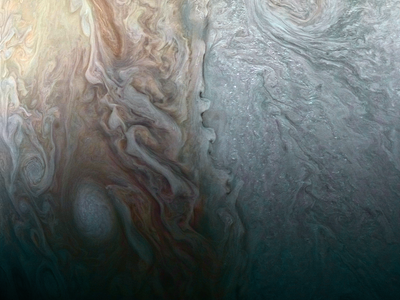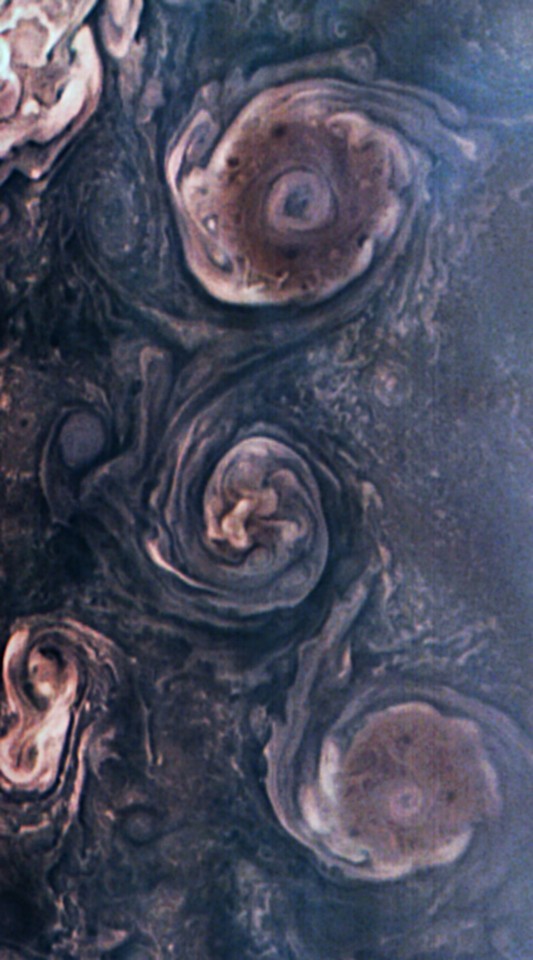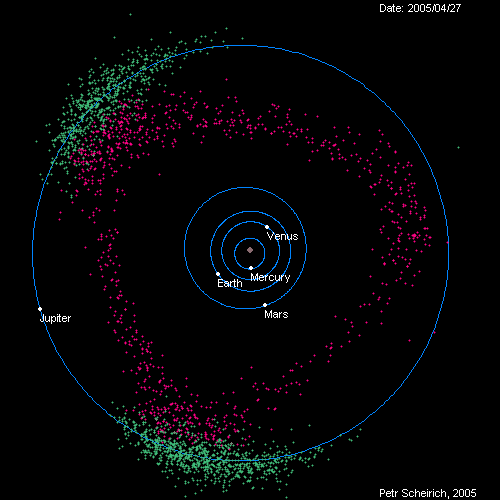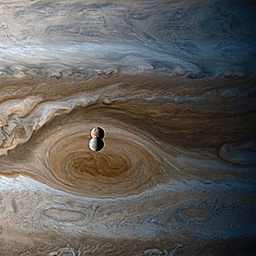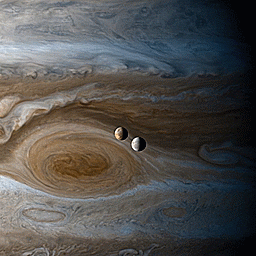
Amateur astronomer, owns a telescope. This is a side blog to satiate my science-y cravings! I haven't yet mustered the courage to put up my personal astro-stuff here. Main blog : @an-abyss-called-life
212 posts
Latest Posts by starry-shores - Page 5
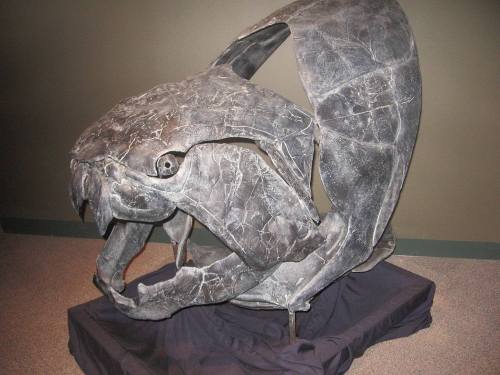

Savage 10 metre fish of the Silurian and Devonian Heavily armoured piscine torpedoes with fierce teeth roamed the oceans in the early days of fishes, in fact the Devonian era is called the age of fishes by palaeontologists as they had a huge burst of speciation and diversified to fill most marine ecological niches during this time. The now extinct (fortunately) class known as placodermi (plate skin in Greek) was the apex predator of these long gone waters, and thrived from 438 to 358 million years ago, dying out at the end Devonian mass extinction (one of the lesser ones).
Keep reading

50 Foot Long Congo Snake
In 1959 Remy Van Lierden was flying over the Katanga region in the Democratic Republic of the Congo. He was flying a helicopter and returning to the base that he commanded in Kamina. As he passed over a clearing in the jungle he noticed a large animal laying out in the sun. What he saw was a 50 foot long snake, with green and brown scales. He couldn’t believe his eyes and neither could his passengers. He circled around and made several passes off the monstrous snake, however he flew away when it got into the striking position and thought it was too dangerous to contour to fly over the animal. During one of the passes he made a passenger on his aircraft snapped this picture to prove what they saw. The snake in question is clearly large and it’s easy to see how it could have been a threat to a low flying helicopter. It’s believed that the snake is a Titanoboa which is thought to be extinct, and has been for millions of years. But it’s possible that the species may have survived. The natives claim that the snake pictured here is a small one and that they can get up to twice and three times the size.
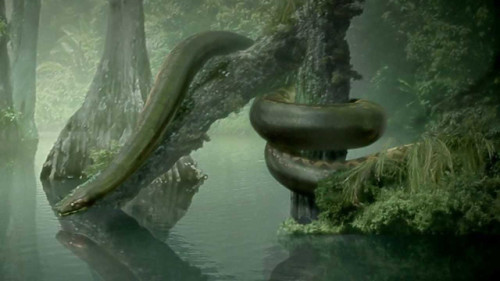

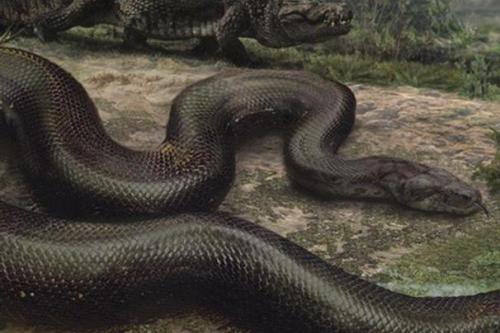
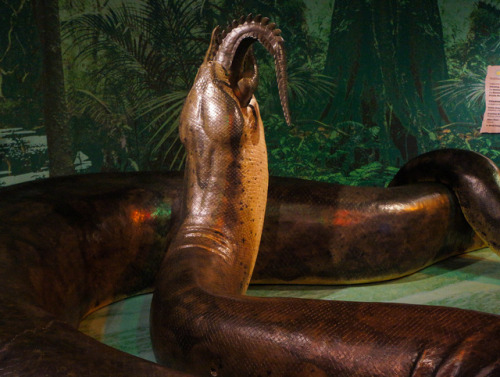
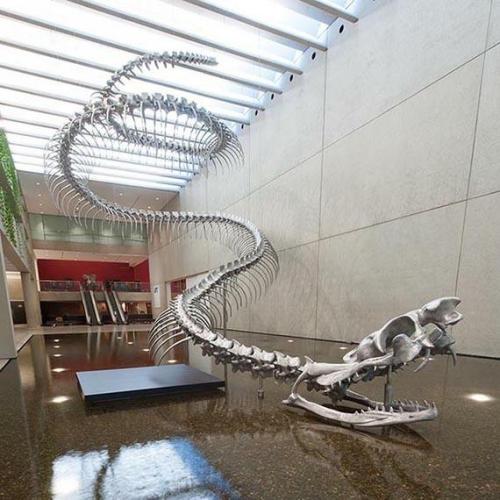

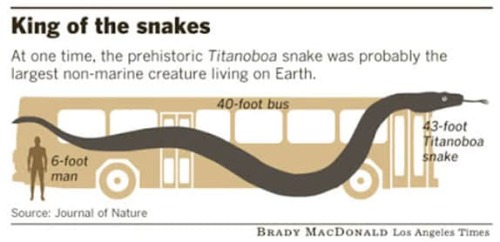
Titanoboa
Titanoboa is an extinct genus of snakes that is known to have lived in present-day La Guajira in northern Colombia. The giant snake lived during the Middle to Late Paleocene epoch, a 10-million-year period immediately following the Cretaceous-Paleogene extinction event.
The only known species is Titanoboa cerrejonensis, the largest snake ever discovered. By comparing the sizes and shapes of its fossilized vertebrae to those of extant snakes, researchers estimated that the largest individuals of T. cerrejonensis found had a total length around 42 feet and weighed about 2,500 pounds.
While initially thought to have been an apex predator of the Paleocene ecosystem in which it lived, evidence has pointed to the genus being predominantly piscivorous. Titanoboa’s massive size would have made it difficult to move on land, so the giant snake would probably have spent most of its life in the water, hunting for fish and other aquatic prey.
RECORD BREAKERS
Life on earth, as magnificent and versatile as it is, is seemingly tame compared to the weird and wonderful creatures that once existed. All categories of life have reached unimaginable sizes, here are just a selection of prehistoric record breakers!

MEGALODON The biggest shark known to have existed, ruling over the oceans as recently as up to a million years ago. A length of almost 20 metres and weighing in at an estimated 48 tonnes, Megalodon could deliver a crucifying bite of up to 110,000N. It is no surprise that the Megalodon was dubbed the “whale killing shark”.
MEGATHERIUM Our early ancestors would have been quite familiar with Megatherium as they existed up to 8000 years ago, they were in fact the largest sloths to have existed. Sloths have a reputation as being lazy, slow and docile, but Megatherium was a 6 metre long, 4 tonne monster with a killer instinct and knife-like claws. Megatherium’s discovery came before that of the dinosaurs. Skeletons of these prehistoric beasts were a delight to the Victorian public and paved the way for the science of palaeontology.

ARCHELON Literally meaning “large turtle”, Archelon certainly was just that. Existing during the cretaceous, the time of the dinosaurs, Archelon could reach 4.5 metres long and may have lived to over 100 years old. Archelon could not compete with other cretaceous beings in speed and agility, but its blade-like beak was able to slice through flesh and crush though the toughest ammonite shells. Unfortunately Archelon appears to have been a popular snack for other marine dwellers, skeletons are frequently missing flippers or heads and covered in slashes.
TITANOBOA When the dinosaurs reign ended, a new era saw the rise of new super-predators, one was Titanoboa, the largest snake ever with a body up to 13 metres long, standing a metre off the ground and weighing up to 2500 pounds. Titanoboa was 30% longer than even todays largest species. Scientists believe this humongous snake hunted like its modern relatives, the boa constrictors, by winding around prey and suffocating them.

IRISH ELK Owner of the largest antlers of any animal, up to 3 metres wide, the Irish Elk gets its name from its frequent discoveries in Irish peat bogs. Existing up to 10,000 years ago, these would have been a common sight in grasslands for our ancestors. Many fossils indicate the animals died of starvation which is why the antlers are thought to have been part of elaborate mating contests between males, often resulting in one being fatally injured and unable to feed itself.
DEINOTHERIUM A distant relative of the elephants and mammoths, Deinotherium was more sinister, its name translates to “terrible beast”, they would have most likely caused trouble for our ancient ancestors around 1.5 million years ago. Deinotherium is actually considered to be the second largest land mammal of all time, behind Paraceratherium and is iconic in appearance due to its sharp, downward facing tusks.
ARCTODUS Known as the short faced bear, they were the biggest bears on record and one of the largest mammal carnivores to have existed. Whilst their skull was short, they were packed with piercing teeth that could deliver a bone crushing bite. Existing up to 11,000 years ago, out ancestors would have stayed well clear of this 900 kilogram predator, with slender limbs and knife-like claws, Arctodus was deadly.

SARCOSUCHUS One of the most infamous fossil discoveries in history, Sarcosuchus was the largest crocodile to walk the Earth up to 112 million years ago, this was a crocodile capable of killing dinosaurs. Sarcosuchus was twice as long as a saltwater crocodile, that’s 11-12 metres long and could reach over 8 tonnes. Its jaw was packed full of 66 teeth either side of its jaw and would have clamped down on prey that wandered too near.
ARGENTINOSAURUS One of the largest lifeforms that has ever stood on the Earth, Argentinosaurus could grow up to 30 metres long with its hind limbs standing 4.5 metres off the ground. They existed between 97-94 million years ago and at adulthood would have been virtually indestructible to predators. Its weight is estimated at a staggering 80-100 tonnes. There hasn’t been another land mammal on the same scale as Argentinosaurus since and it’s unlikely there ever will be.

SPINOSAURUS The largest discovered therapod ever, a group that includes Allosaurus and Tryrannosaurus. Spinosaurus remained an enigma to scientists for decades, the only discovered specimen was sadly destroyed during World War 2 and was not rediscovered until the 21st century. Spinosaurus is thought to have reached up to 16 metres long and weighed in around 12 tonnes, that is almost double the weight of a T-rex!
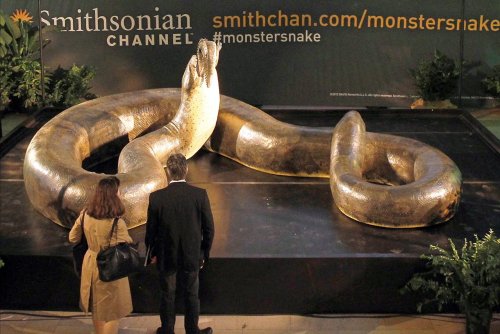

The Titanoboa, is a 48ft long snake dating from around 60-58million years ago. It had a rib cage 2ft wide, allowing it to eat whole crocodiles, and surrounding the ribcage were muscles so powerful that it could crush a rhino. Titanoboa was so big it couldn’t even spend long amounts of time on land, because the force of gravity acting on it would cause it to suffocate under its own weight.

Can you believe this monster snake actually existed?
Titanoboa is an extinct genus of very large snakes that lived in what is now La Guajira in northeastern Colombia. They could grow up to 12.8 m long and reach a weight of 1,135 kg. Fossils of Titanoboa have been found in the Cerrejón Formation, and date to around 58 to 60 million years ago.
Titanoboa skeleton on display at Queensland Art Gallery
sauropod emojis, as rated by a palaeontology student
apple:

not a bad start here overall! this is recognisably intended as a brachiosaurid, and the skull shape and overall profile are pretty good (though they look a bit juvenile-ish). points off, though, for the inaccurate hands - rather than elephantine columns, they were more shaped like lima beans in cross-section. yes, really. they also only had one claw per hand (it was on the thumb). also points off for having the external fleshy nostril located on the dome of the skull; while this is the position of the bony external nostril, there is evidence that the fleshy nostril was probably located at the tip of the snout. its dead eye haunts me
score: 7/10 solid attempt
google:

google clearly went for a cartoonier approach, and to my view it served them well. still recognisably a brachiosaur - the shape of the skull and overall proportions make it resemble Europasaurus, a type of dwarf sauropod that lived on an island in what is now eastern europe. which immediately ups its score in my book. however, it falls victim to the same issues with elephantine hands as did the apple one, and as such i can’t give it a perfect score.
score: 9/10 friendly!
microsoft:

this emoji cleverly avoids any scientific inaccuracies by being extremely cartoony. i like the use of single colours rather than gradients. a little too simple for my tastes though. i can’t tell what find of sauropod, if any, it was intended to be - a brachiosaur, because of the upright neck? a mamenchisaur, maybe? i have little to work with.
score: 6/10 just too vague
samsung:

i don’t like her at all. clearly a brachiosaur - sensing a common theme - but something about it is just unpleasant to me. the body seems too fat, the limbs too short, the tail too noodly, the head too pointy. also messes up the hands again.
score: 3/10. please leave.
whatsapp:

at last, an emoji that bucks the brachiosaur trend!! this is clearly not a brachiosaur. in fact, it looks like a possible Cetiosaurus-type deal. whatever it is, it’s charming. the nostrils are at the end of the snout as they should be and - is it? - can it be? - it is! the hands are anatomically correct! each clearly has one claw, located on the thumb, and though we can’t see well, they don’t appear to be elephantine. i love them a lot.
score: 10/10 only shooting stars break the mold - oh god im so sorry i shouldve phrased that differently–
twitter:

a classic. what it lacks in detail it makes up in simplicity. it has pleasant lines and an appealing silhouette. it’s extremely vague and not based off of any real genus, and the tail is far too short, but for some reason this doesn’t bother me too much.
score: 8/10. exquisite
facebook:

hm. hmm. a lot of anatomical though was clearly put into this; overall the body form looks like a plausible sauropod. the proportions look a little weird, sure, but that seems to be perspective - after all, most sauropods were gigantic beings. beefy boys, if you will. its nostrils, upon close inspection, are correctly placed; however, its hands and feet are all messed up. i guess the real conundrum for me is that it seems to be a mish-mash of sauropods - remove the braciosaur-like domed skull, and it would be a great fit for an Apatosaurus.
score: 8/10 i’m conflicted
joypixels

what in the hell is joypixels? and what in the hell is this? i just…the hands and feet are plantigrade, meaning that the ankles touch the ground, when actual sauropods were digitigrade - walking on their toes. the shoulder and hip muscles aren’t there, and instead the limbs are just awkwardly connected to the body. it reminds me of a turtle, and not in a good way.
score: 4/10. uninspired and dull
openmoji:

they didnt try. nor will i.
score: 0/10 make an effort
emojidex

every emojidex emoji i have ever seen has just been awful. this is no different. this looks like a stereotypical loser from a meme, but as a dinosaur. the contrast between the decently moderate level of artistic detail put in and the blatant disinterest towards making it look like an animal is staggering. just awful.
score: -3/10 i just cant care enough about it to rate it lower
emojipedia:

excuse me? what the fuck? what the fuck is this? this is the main character from the low-budget ripoff of the good dinosaur. the head looks like a Corythosaurus and the body looks like barney in leapfrog stance. the gradients just make me feel a little sick. it’s awful. look at the hindlimbs and tell me that any love was put into drawing this. it’s like how a dinosaur would be drawn on tom and jerry but like, the bad charmless ones made in the 90s that were trying hard to emulate the originals. the hands look like green snowboots.
score: -500/10 i hate you i hate you i hate you i hate you i hate you i hate you




Bioluminescent Plankton
Scientists have only recently discovered that this type of plankton glows when they are moved because of stress - ironic when you consider how relaxing the sight of the shimmering waves are in the dark night. Bioluminescence is used as a defence mechanism to draw predators towards the creature trying to eat the plankton. The tiny flashes of light also disorientate and surprise the predator.
These tiny organisms produce light using a chemical called luciferin. The process of creating a bioluminescent light, which is simply light produced within a living creature, differs between organisms. Some need a particular food or another creature for the effect to happen. But this type of plankton, called dinoflagellates, produce luciferin on their own. The light the tiny plankton emit is called ‘cold light’, meaning less than 20% of the light generates heat.
Huge areas of the ocean can become populated by glowing plankton but the effect is especially common in warm-water lagoons that have narrow openings to the sea. This causes the plankton to gather and become trapped, causing the water to turn orange.
Image credit: Will Ho, Kin Cheung, Landscapes Maldives & eyegami
Source: Kuoni
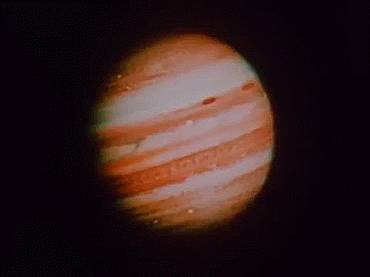
Jupiter seen by NASA’s Voyager spacecraft
Animation taken from video: Jeff Quitney
Stars, Sea, and Smoke from the ISS: Tournament Earth 2021
We started Tournament Earth with 32 photos taken by astronauts from the Interantional Space Station and now we are down to 8. All of the #1 seeds are gone. Two #8 seeds are dominating their groups. Who will win? Let's take a closer look at the competitors still in the game. Then remember to vote for your favorites. The champion will be announced on April 13, 2021.
Stars in Motion vs. Cleveland Volcano
This matchup pits smoke against stars, but both have interesting stories.

The International Space Station (ISS) is constantly in motion. For astronaut photographers on board, that motion has consequences. For one, it makes it challenging to take photos. The same motion makes it possible to shoot spectacular photos like the one above. The image is compiled from a series of photographs taken by astronaut Don Pettit while he was onboard the ISS in April 2012. This composite was made from more than 72 individual long-exposure photographs taken over several minutes as the ISS traveled over the Caribbean Sea, across South America, and over the South Atlantic Ocean.

Astronaut Jeff Williams was the first to witness activity at the Cleveland Volcano on May 3, 2006. The Cleveland Volcano is one of the most active in the Aleutian Islands, which extend west-southwest from the Alaska mainland. It is a stratovolcano composed of alternating layers of hardened lava, compacted volcanic ash, and volcanic rocks. The event proved to be short-lived; two hours later, the plume had completely detached from the volcano. The ash cloud height could have been as high as 6,000 meters (20,000 feet) above sea level.
Stargazing from the ISS vs. Cruising Past the Aurora Borealis
This is the most stellar matchup of the tournament, literally. Two beloved star pictures face off in what will be one of the most difficult choices of the tournament.

An astronaut took this broad, short-lens photograph of Earth’s night lights while looking out over the remote reaches of the central equatorial Pacific Ocean. The ISS was passing over the island nation of Kiribati at the time, about 2600 kilometers (1,600 miles) south of Hawaii. Scientists identified the pattern of stars in the photo as our Milky Way galaxy (looking toward its center). The dark patches are dense dust clouds in an inner spiral arm of our galaxy; such clouds can block our view of stars toward the center. The curvature of the Earth crosses the center of the image and is illuminated by a variety of airglow layers in orange, green, and red.

Commonly known as the northern lights, these colorful ribbons of light appear to dance in the sky over the planet’s high latitudes, attracting sky chasers and photographers. Astronaut Randy “Komrade” Bresnik shot this photograph on September 15, 2017, as the space station passed over Ontario, Canada. Curtains of green—the most familiar color of auroras—dominate the light show, with hints of purple and red.
Rolling Through the Appalachians vs. Castellanus Cloud Tower

The Susquehanna River cuts through the folds of the Valley-and-Ridge province of the Appalachian Mountains in this photograph taken from the International Space Station by astronaut Christina Koch. The Valley-and-Ridge province is a section of the larger Appalachian Mountain Belt between the Appalachian Plateau and the Blue Ridge physiographic provinces. The northeast-southwest trending ridges are composed of Early Paleozoic sedimentary rocks. The valleys between them were made of softer rocks (limestone and shales) that were more susceptible to erosion; they are now occupied by farms.

An astronaut aboard the International Space Station took this photograph of a massive vertical cloud formation—known to meteorologists as cumulus castellanus—above Andros Island. The cloud name castellanus comes from the similarity to the crenellated towers or turrets of medieval castles. These clouds develop due to strong vertical air movement typically associated with thunderstorms.
Lake Van, Turkey vs. Typhoon Maysak from the Space Station

While orbiting on the International Space Station, astronaut Kate Rubins shot this photograph of part of Lake Van in Turkey, the largest soda or alkaline lake on Earth. Generally, soda lakes are distinguished by high concentrations of carbonate species. Lake Van is an endorheic lake—it has no outlet, so its water disappears by evaporation—with a pH of 10 and high salinity levels.

This photograph of super typhoon Maysak was taken by European Space Agency astronaut Samantha Cristoforetti as the International Space Station passed near the storm on March 31, 2015. The category 4 typhoon was headed for a possible landfall in the Philippines by the end of the week. It was unusual for the western Pacific to see such a strong storm so early in the year.
See all of the images and vote HERE. Follow @NASAEarth on social media for updates.
Make sure to follow us on Tumblr for your regular dose of space: http://nasa.tumblr.com
Ten interesting facts about Uranus
Like the classical planets, Uranus is visible to the naked eye, but it was never recognised as a planet by ancient observers because of its dimness and slow orbit. Sir William Herschel announced its discovery on 13 March 1781, expanding the known boundaries of the Solar System for the first time in history and making Uranus the first planet discovered with a telescope.

Uranus is the seventh planet from the Sun. It has the third-largest planetary radius and fourth-largest planetary mass in the Solar System. Uranus is similar in composition to Neptune, and both have different bulk chemical composition from that of the larger gas giants Jupiter and Saturn.

(The five largest moons of Uranus) Like all of the giant planets, Uranus has its share of moons. At present, astronomers have confirmed the existence of 27 natural satellites. But for the most part, these moons are small and irregular.

Uranus’ moons are named after characters created by William Shakespeare and Alexander Pope. These include Oberon, Titania and Miranda. All are frozen worlds with dark surfaces. Some are ice and rock mixtures. The most interesting Uranian moon is Miranda; it has ice canyons, terraces, and other strange-looking surface areas.

Only one spacecraft in the history of spaceflight has ever made a close approach to Uranus. NASA’s Voyager 2 conducted its closest approach to Uranus on January 24th, 1986, passing within 81,000 km of the cloud tops of Uranus. It took thousands of photographs of the gas/ice giant and its moons before speeding off towards its next target: Neptune.

Uranus has rings: All the gas and ice giants have their own ring systems, and Uranus’ is the second most dramatic set of rings in the Solar System.

Uranus makes one trip around the Sun every 84 Earth years. During some parts of its orbit one or the other of its poles point directly at the Sun and get about 42 years of direct sunlight. The rest of the time they are in darkness.
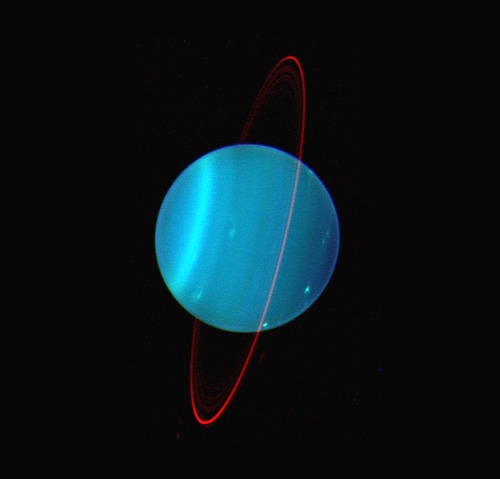
All of the planets in the Solar System rotate on their axis, with a tilt that’s similar to the Sun. In many cases, planet’s have an axial tilt, where one of their poles will be inclined slightly towards the Sun. But the axial tilt of Uranus is a staggering 98 degrees! In other words, the planet is rotating on its side.

Uranus is approximately 4 times the sizes of Earth and 63 times its volume.

Uranus is blue-green in color, the result of methane in its mostly hydrogen-helium atmosphere. The planet is often dubbed an ice giant, since 80 percent or more of its mass is made up of a fluid mix of water, methane, and ammonia ices.

Uranus hits the coldest temperatures of any planet. With minimum atmospheric temperature of -224°C Uranus is nearly coldest planet in the solar system. While Neptune doesn’t get as cold as Uranus it is on average colder. The upper atmosphere of Uranus is covered by a methane haze which hides the storms that take place in the cloud decks.
source
source
source
Images credit: NASA/ wikipedia

The Aurora Named STEVE by NASA Goddard Photo and Video
What are brown dwarfs?
In order to understand what is a brown dwarf, we need to understand the difference between a star and a planet. It is not easy to tell a star from a planet when you look up at the night sky with your eyes. However, the two kinds of objects look very different to an astronomer using a telescope or spectroscope. Planets shine by reflected light; stars shine by producing their own light. So what makes some objects shine by themselves and other objects only reflect the light of some other body? That is the important difference to understand – and it will allow us to understand brown dwarfs as well.

As a star forms from a cloud of contracting gas, the temperature in its center becomes so large that hydrogen begins to fuse into helium – releasing an enormous amount of energy which causes the star to begin shining under its own power. A planet forms from small particles of dust left over from the formation of a star. These particles collide and stick together. There is never enough temperature to cause particles to fuse and release energy. In other words, a planet is not hot enough or heavy enough to produce its own light.

Brown dwarfs are objects which have a size between that of a giant planet like Jupiter and that of a small star. In fact, most astronomers would classify any object with between 13 times the mass of Jupiter and 75 times the mass of Jupiter to be a brown dwarf. Given that range of masses, the object would not have been able to sustain the fusion of hydrogen like a regular star; thus, many scientists have dubbed brown dwarfs as “failed stars”.

A Trio of Brown Dwarfs
This artist’s conception illustrates what brown dwarfs of different types might look like to a hypothetical interstellar traveler who has flown a spaceship to each one. Brown dwarfs are like stars, but they aren’t massive enough to fuse atoms steadily and shine with starlight – as our sun does so well.

On the left is an L dwarf, in the middle is a T dwarf, and on the right is a Y dwarf. The objects are progressively cooler in atmospheric temperatures as you move from left to right. Y dwarfs are the newest and coldest class of brown dwarfs and were discovered by NASA’s Wide-field Infrared Survey Explorer, or WISE. WISE was able to detect these Y dwarfs for the first time because it surveyed the entire sky deeply at the infrared wavelengths at which these bodies emit most of their light. The L dwarf is seen as a dim red orb to the eye. The T dwarf is even fainter and appears with a darker reddish, or magenta, hue. The Y dwarf is dimmer still. Because astronomers have not yet detected Y dwarfs at the visible wavelengths we see with our eyes, the choice of a purple hue is done mainly for artistic reasons. The Y dwarf is also illustrated as reflecting a faint amount of visible starlight from interstellar space.
In this rendering, the traveler’s spaceship is the same distance from each object. This illustrates an unusual property of brown dwarfs – that they all have the same dimensions, roughly the size of the planet Jupiter, regardless of their mass. This mass disparity can be as large as fifteen times or more when comparing an L to a Y dwarf, despite the fact that both objects have the same radius. The three brown dwarfs also have very different atmospheric temperatures. A typical L dwarf has a temperature of 2,600 degrees Fahrenheit (1,400 degrees Celsius). A typical T dwarf has a temperature of 1,700 degrees Fahrenheit (900 degrees Celsius). The coldest Y dwarf so far identified by WISE has a temperature of less than about 80 degrees Fahrenheit (25 degrees Celsius).
Sources: starchild.gsfc.nasa.gov & nasa.gov
image credit: NASA / JPL-Caltech

Stars and Dust in Corona Australis : Cosmic dust clouds and young, energetic stars inhabit this telescopic vista, less than 500 light-years away toward the northern boundary of Corona Australis, the Southern Crown. The dust clouds effectively block light from more distant background stars in the Milky Way. But the striking complex of reflection nebulae cataloged as NGC 6726, 6727, and IC 4812 produce a characteristic blue color as light from the region’s young hot stars is reflected by the cosmic dust. The dust also obscures from view stars still in the process of formation. At the left, smaller yellowish nebula NGC 6729 bends around young variable star R Coronae Australis. Just below it, glowing arcs and loops shocked by outflows from embedded newborn stars are identified as Herbig-Haro objects. On the sky this field of view spans about 1 degree. That corresponds to almost 9 light-years at the estimated distance of the nearby star forming region. via NASA

The Sun from the Internation Space Station

Cassini Observes Sunsets on Titan (Artist’s Rendering) by NASA on The Commons
Walking the edge of Bromo Crater. Would you hike this route ? East Java, Indonesia 🇮🇩 🎥 @backpackertampan
planetearthtv

Stars
Stars are the most widely recognized astronomical objects, and represent the most fundamental building blocks of galaxies. The age, distribution, and composition of the stars in a galaxy trace the history, dynamics, and evolution of that galaxy. Moreover, stars are responsible for the manufacture and distribution of heavy elements such as carbon, nitrogen, and oxygen, and their characteristics are intimately tied to the characteristics of the planetary systems that may coalesce about them. Consequently, the study of the birth, life, and death of stars is central to the field of astronomy.
How do stars form?
Stars are born within the clouds of dust and scattered throughout most galaxies. A familiar example of such as a dust cloud is the Orion Nebula.

Turbulence deep within these clouds gives rise to knots with sufficient mass that the gas and dust can begin to collapse under its own gravitational attraction. As the cloud collapses, the material at the center begins to heat up. Known as a protostar, it is this hot core at the heart of the collapsing cloud that will one day become a star.

Three-dimensional computer models of star formation predict that the spinning clouds of collapsing gas and dust may break up into two or three blobs; this would explain why the majority the stars in the Milky Way are paired or in groups of multiple stars.

As the cloud collapses, a dense, hot core forms and begins gathering dust and gas. Not all of this material ends up as part of a star — the remaining dust can become planets, asteroids, or comets or may remain as dust.

In some cases, the cloud may not collapse at a steady pace. In January 2004, an amateur astronomer, James McNeil, discovered a small nebula that appeared unexpectedly near the nebula Messier 78, in the constellation of Orion. When observers around the world pointed their instruments at McNeil’s Nebula, they found something interesting — its brightness appears to vary. Observations with NASA’s Chandra X-ray Observatory provided a likely explanation: the interaction between the young star’s magnetic field and the surrounding gas causes episodic increases in brightness.
Main Sequence Stars
A star the size of our Sun requires about 50 million years to mature from the beginning of the collapse to adulthood. Our Sun will stay in this mature phase (on the main sequence as shown in the Hertzsprung-Russell Diagram) for approximately 10 billion years.

Stars are fueled by the nuclear fusion of hydrogen to form helium deep in their interiors. The outflow of energy from the central regions of the star provides the pressure necessary to keep the star from collapsing under its own weight, and the energy by which it shines.

As shown in the Hertzsprung-Russell Diagram, Main Sequence stars span a wide range of luminosities and colors, and can be classified according to those characteristics. The smallest stars, known as red dwarfs, may contain as little as 10% the mass of the Sun and emit only 0.01% as much energy, glowing feebly at temperatures between 3000-4000K. Despite their diminutive nature, red dwarfs are by far the most numerous stars in the Universe and have lifespans of tens of billions of years.

On the other hand, the most massive stars, known as hypergiants, may be 100 or more times more massive than the Sun, and have surface temperatures of more than 30,000 K. Hypergiants emit hundreds of thousands of times more energy than the Sun, but have lifetimes of only a few million years. Although extreme stars such as these are believed to have been common in the early Universe, today they are extremely rare - the entire Milky Way galaxy contains only a handful of hypergiants.
Stars and Their Fates
In general, the larger a star, the shorter its life, although all but the most massive stars live for billions of years. When a star has fused all the hydrogen in its core, nuclear reactions cease. Deprived of the energy production needed to support it, the core begins to collapse into itself and becomes much hotter. Hydrogen is still available outside the core, so hydrogen fusion continues in a shell surrounding the core. The increasingly hot core also pushes the outer layers of the star outward, causing them to expand and cool, transforming the star into a red giant.

If the star is sufficiently massive, the collapsing core may become hot enough to support more exotic nuclear reactions that consume helium and produce a variety of heavier elements up to iron. However, such reactions offer only a temporary reprieve. Gradually, the star’s internal nuclear fires become increasingly unstable - sometimes burning furiously, other times dying down. These variations cause the star to pulsate and throw off its outer layers, enshrouding itself in a cocoon of gas and dust. What happens next depends on the size of the core.

Average Stars Become White Dwarfs
For average stars like the Sun, the process of ejecting its outer layers continues until the stellar core is exposed. This dead, but still ferociously hot stellar cinder is called a White Dwarf. White dwarfs, which are roughly the size of our Earth despite containing the mass of a star, once puzzled astronomers - why didn’t they collapse further? What force supported the mass of the core? Quantum mechanics provided the explanation. Pressure from fast moving electrons keeps these stars from collapsing. The more massive the core, the denser the white dwarf that is formed. Thus, the smaller a white dwarf is in diameter, the larger it is in mass! These paradoxical stars are very common - our own Sun will be a white dwarf billions of years from now. White dwarfs are intrinsically very faint because they are so small and, lacking a source of energy production, they fade into oblivion as they gradually cool down. This fate awaits only those stars with a mass up to about 1.4 times the mass of our Sun. Above that mass, electron pressure cannot support the core against further collapse. Such stars suffer a different fate as described below.

Supernovae Leave Behind Neutron Stars or Black Holes
Main sequence stars over eight solar masses are destined to die in a titanic explosion called a supernova. A supernova is not merely a bigger nova. In a nova, only the star’s surface explodes. In a supernova, the star’s core collapses and then explodes. In massive stars, a complex series of nuclear reactions leads to the production of iron in the core. Having achieved iron, the star has wrung all the energy it can out of nuclear fusion - fusion reactions that form elements heavier than iron actually consume energy rather than produce it. The star no longer has any way to support its own mass, and the iron core collapses. In just a matter of seconds the core shrinks from roughly 5000 miles across to just a dozen, and the temperature spikes 100 billion degrees or more. The outer layers of the star initially begin to collapse along with the core, but rebound with the enormous release of energy and are thrown violently outward. Supernovae release an almost unimaginable amount of energy. For a period of days to weeks, a supernova may outshine an entire galaxy. Likewise, all the naturally occurring elements and a rich array of subatomic particles are produced in these explosions. On average, a supernova explosion occurs about once every hundred years in the typical galaxy. About 25 to 50 supernovae are discovered each year in other galaxies, but most are too far away to be seen without a telescope.
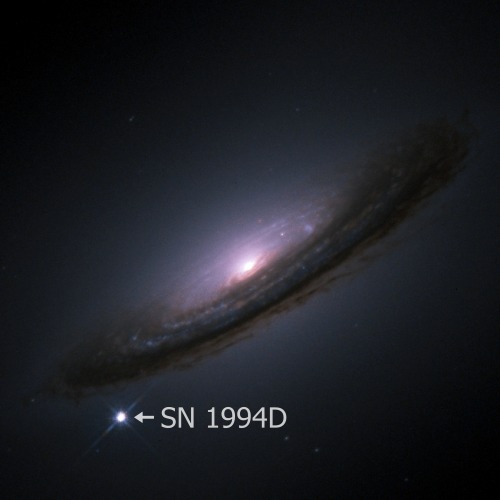
Neutron Stars
If the collapsing stellar core at the center of a supernova contains between about 1.4 and 3 solar masses, the collapse continues until electrons and protons combine to form neutrons, producing a neutron star. Neutron stars are incredibly dense - similar to the density of an atomic nucleus. Because it contains so much mass packed into such a small volume, the gravitation at the surface of a neutron star is immense.
Neutron stars also have powerful magnetic fields which can accelerate atomic particles around its magnetic poles producing powerful beams of radiation. Those beams sweep around like massive searchlight beams as the star rotates. If such a beam is oriented so that it periodically points toward the Earth, we observe it as regular pulses of radiation that occur whenever the magnetic pole sweeps past the line of sight. In this case, the neutron star is known as a pulsar.

Black Holes
If the collapsed stellar core is larger than three solar masses, it collapses completely to form a black hole: an infinitely dense object whose gravity is so strong that nothing can escape its immediate proximity, not even light. Since photons are what our instruments are designed to see, black holes can only be detected indirectly. Indirect observations are possible because the gravitational field of a black hole is so powerful that any nearby material - often the outer layers of a companion star - is caught up and dragged in. As matter spirals into a black hole, it forms a disk that is heated to enormous temperatures, emitting copious quantities of X-rays and Gamma-rays that indicate the presence of the underlying hidden companion.

From the Remains, New Stars Arise
The dust and debris left behind by novae and supernovae eventually blend with the surrounding interstellar gas and dust, enriching it with the heavy elements and chemical compounds produced during stellar death. Eventually, those materials are recycled, providing the building blocks for a new generation of stars and accompanying planetary systems.

Credit and reference: science.nasa.gov
image credit: ESO, NASA, ESA, Hubble
Incredible view of Fanjingshan or mount Fanjing, Guizhou, China
Guizhou, China 😍✈️





